The Black Forest Travel Guide
The Black Forest covers hills of birch and pine along 100 miles (161km) of southwest Germany's border with France. It's renowned as a popular holiday destination in Germany, featuring picturesque fairytale villages, spa-bath resorts, hiking trails and ski resorts.
The first famous holidaymaker to enjoy rest and recuperation in the Black Forest was the Roman Emperor Caracalla, who stopped to sample the natural spring waters in what is now the town of Baden-Baden, around 2,000 years ago. Since then, the Black Forest has been a chosen destination for the rich and famous, with anyone who is anyone revelling in the forest's natural beauty, from Napoleon to Mark Twain.
In medieval times, the local people developed the traditional skills of woodcarving, glass-blowing, and jewellery- and clock-making, and these art forms are still cultivated today, much to the delight of tourists. The amazing variety of clocks in the Black Forest is particularly famous, as are its local food delicacies such as Black Forest ham and cherry cake.
The most central town in the Black Forest is Freudenstadt, serving as the starting point for hundreds of miles of hiking and ski-trails through nearby hills. Most visitors prefer to find accommodation in guest lodges in the small villages sprinkled throughout the region, exploring by car, foot or bicycle.
Things to do in The Black Forest
The Black Forest has been delighting travellers since the height of the Roman Empire. It offers impressive castles, medieval villages and charming handicrafts, ensuring a visit to the region is extremely rewarding and culturally-enriching.
The most famous attractions in the Black Forest are the picturesque villages, many of which would not seem out of place in fairytales. One of the most renowned is the spa resort of Baden-Baden, which has attracted royalty and aristocracy for centuries with its remarkable architecture and natural springs. Other lovely towns include Triberg and Pforzheim, while the cities of Freiburg and Freudenstadt both have charms of their own and make good bases for exploring the region.
Of the many popular things to see and do in the Black Forest, shopping often tops the list. This is because the traditional crafts of the region are of an extremely high quality, so much so that there are several wonderful museums dedicated to showcasing the local woodwork, jewellery and glassware. Clocks are perhaps the most famous products, with the captivating German Clock Museum in Baden-Wurttemberg the best place to really get to grips with the horological traditions.
The Hohenzollern Castle is without a doubt the most awe-inspiring sight in the region; a massive 15th-century fortress with a fairytale facade, spectacularly situated atop a hill overlooking the surrounding countryside. But there are numerous other old forts in the Black Forest, such as Karlsruhe Palace, Eberstein Castle and the ruins of Hohengeroldseck Castle.
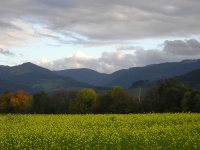
Freiburg
Known for its Black Forest cake and cuckoo clocks, the gorgeous city of Freiburg has plenty to offer. The recommended way to explore the town and surrounds is on two wheels along the more than 93 miles (150km) of bicycle paths. More of a large town, Freiburg is known for its university, magnificent cathedral and medieval treasures, and a somewhat bohemian vibe with street musicians and pavement artists. The Altstadt (Old City) features canals and dozens of historic buildings. A cable car carries passengers on scenic trips up the Schauinsland Mountain from the Stadtgarten, affording views from the mountaintop restaurant.
The local Black Forest cuisine is usually a big hit, as is the local wine. The weather in Freiburg is sunny and warm compared to other parts of Germany, and the city takes full advantage of this to host several festivals throughout the year, including a music festival in mid-June each year, a wine festival at the end of June and another in mid-August.
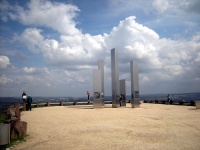
Pforzheim
Pforzheim is today the centre for traditional jewellery and clock-making in Germany. The town is home to the fascinating Technisches Museum, commemorating the important role time-keeping has played in Pforzheim's history, and featuring a reconstruction of a clock-making studio in the 19th century, among other things. Jewellery is important too, and the Schmuckmuseum collection features pieces dating back to the 3rd century BC. There's also an interesting Alpine Garden that has 100,000 or more varieties of high-altitude plants growing in a natural setting beside the Wurm River. Up to 80 percent of Pforzheim's buildings were destroyed in World War II, meaning it looks much more modern than one would expect for a settlement founded by the ancient Romans.
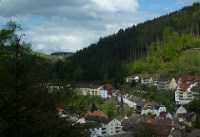
Triberg
Triberg is a charming village in the Black Forest, with the region's true spirit brought to life in the Schwarzwald-Museum of Triberg. It documents the old traditions and lifestyle of this unique area with exhibits of costumes, handcrafts and furnishings. Another of Triberg's more intriguing attractions is the Baroque pilgrimage church called Maria in the Fir from the 18th century. Nearby Gutach contains original Black Forest homes up to four centuries old, while one of Germany's highest waterfalls runs down the mountainside in seven stages, and is accessible by a lovely walking trail. Further south, a huge variety of elaborate clocks are on display at the German Clock Museum in Furtwangen, while the Baden Black Forest Railway runs through spectacular mountain and forest scenery.
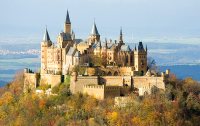
Hohenzollern Castle
The magnificent castle at Hohenzollern is perched on a hilltop 31 miles (50km) outside of Stuttgart. The current structure was built in the 15th century, although mention of a castle on the site dates back to 1267. The second Hohenzollern Castle was constructed in 1454 to be bigger and more heavily fortified than before. During the Thirty Years War, it was used as a fortress, changing hands between several families. The castle is incredible, with a fairytale Gothic Revival facade set against spectacular panoramic views of the surrounding Black Forest countryside. It's widely acknowledged as a triumph of 19th-century military architecture and its many towers are some of its most striking features.

German Clock Museum
The German Clock Museum's massive collection of timepieces is the most comprehensive in the world, offering over 8,000 examples of clocks that have been collected over the last 150 years. Cuckoo clocks have been made in the Black Forest since the early 18th century, with much of the region's history, culture and development mirrored in its clock-making past. Mapping the advances of clock-making is quite intriguing and, while some of the pieces are beautiful, others are remarkable for their originality; there is an ingenious alarm clock designed for a deaf couple that uses a flashing light instead of a bell.
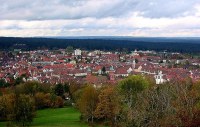
Freudenstadt
The largest city in the Black Forest region of Germany, Freudenstadt is a popular base from which to explore the stunning surroundings. Known for its sunny weather, the city lures visitors with its many outdoor attractions, such as the largest marketplace in Germany and the Parkwald, which is the country's biggest nature reserve. There are also interesting historical sites, mainly the Stadtkirche, which dates back to the 17th century. Visitors to Freudenstadt can also enjoy the many good restaurants serving up tasty local cuisine. But most visitors holiday in Freudenstadt to engage in some of the best skiing, hiking and camping in the Black Forest. Freudenstadt is conveniently situated on the Schwarzwald Hochstrasse highway, which stretches to Baden-Baden and meanders past many quaint shops, cafes and popular ski slopes.
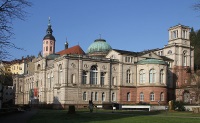
Baden-Baden
The playground of Europe's royalty and aristocracy in the early 1800s, Baden-Baden sits in the heart of the Black Forest, and its Friedrichsbad bathhouse is perfect for those seeking rest and recuperation in steamy marble confines and mineral waters. Male and female facilities remain separate, and the roughly three-hour bathing routine follows a strict regimen of hot-air blasts, steam baths and massages. Nearby are the equally famous Baths of Caracalla, which feature indoor and outdoor waterfalls, swimming pools and hot tubs, and a 2,000-year-old Roman bath. Its magnificent casino was built in the 1850s in the style of the Palace of Versailles, while the area is also home to several art museums, a concert hall and the Castle Hohenbaden.
Germany travel info
Electricity
230 volts, 50Hz. European-style two-pin plugs are standard.
Language
German is the official language. English is also widely spoken and understood.
Money
The unit of currency is the Euro (EUR), divided into 100 cents. ATMs and exchange bureaux are widely available. The major credit cards are widely accepted in large shops, hotels and restaurants. The quickest and most convenient way to change money is to obtain cash from one of the ATMs that are ubiquitous features on all German streets. Banks are closed on weekends, but exchange bureaux at airports and main railway stations are open daily.
Tipping
German law stipulates that all prices, menus and bills include both tax and a service charge, so tipping is not necessary in restaurants. Cleaning staff, hairdressers, taxi drivers and other menial services appreciate small tips.
Health
There are no serious health risks for visitors to Germany and no vaccinations are required. The German health service is excellent and there is a reciprocal health agreement with most EU countries, whose citizens are entitled to free medical and dental treatment on presentation of a European Health Insurance Card (EHIC). After Brexit, the Global Health Insurance Card (GHIC) replaced the European Health Insurance Card (EHIC) for UK citizens. The GHIC allows UK citizens access to state healthcare during visits to the EU. The GHIC is not valid in Norway, Iceland, Liechtenstein or Switzerland, nor is it an alternative to travel insurance. Nationals of other countries should take out travel insurance.
Safety
A visit to Germany should be trouble free, but visitors should take normal precautions to avoid mugging, bag-snatching and pick-pocketing, especially at airports, railway stations and markets in the large cities.
Local customs
Visitors are not required to carry their passports with them at all times in Germany, but carrying some form of identification is advised. Smoking in public places such as bars and restaurants is illegal.
Doing business
In Germany, business is conducted in a formal manner, with a conservative and formal dress code being the norm. Punctuality is vital at all meetings and it's considered rude to be late. Germans use titles often, with men referred to as 'Herr' and women as 'Frau', followed by their last names.
Meetings are often purely business and may not occur over lunches, which are generally more social. Shaking hands at the beginning and end of the meeting is common. Business hours are generally 9am to 6pm Monday to Friday, with an hour taken over lunch.
Duty free
Passengers arriving from EU countries can enter Germany without paying duty on 800 cigarettes or 400g cigarillos or 200 cigars or 1kg tobacco; 90 litres of still wine; 110 litres of beer; and 10 litres of alcohol stronger than 20 percent or 20 litres of fortified wine, sparkling wine or other liqueurs up to 22 percent.
Passengers arriving from non-EU countries, over the age of 17, can enter Germany without paying duty on 200 cigarettes or 100 cigarillos or 50 cigars or 250g smoking tobacco; 4 litres of wine and 16 litres of beer and 1 litre of spirits over 22 percent volume; or 2 litres of spirits under 22 percent volume. Other goods to the value of €430 for travellers arriving by air or sea, and €300 for travellers arriving by land.
Communications
The international access code for Germany is +49. Travellers will find it easy to use a local SIM card, Skype, WhatsApp or similar apps. Free WiFi is available in most hotels, cafes and restaurants.
Passport & Visa
The borderless region known as the Schengen Area includes the following countries: Austria, Belgium, Czech Republic, Denmark, Estonia, Finland, France, Germany, Greece, Hungary, Iceland, Italy, Latvia, Lithuania, Luxembourg, Malta, The Netherlands, Norway, Poland, Portugal, Slovakia, Slovenia, Spain, Sweden, and Switzerland. All these countries issue a standard Schengen visa that has a multiple entry option, and which allows the holder to travel freely within the borders of all the aforementioned countries. Additionally, non-EEA members require proof of onward or return tickets, the necessary travel documentation for their next destination, and sufficient funds to support themselves while in Germany. Citizens of Australia, Canada, Israel, Japan, New Zealand, Switzerland, and the USA are exempt from the requirement to hold onward tickets.
It is highly recommended that travellers' passports have at least six months' validity remaining after the intended date of departure from their travel destination. Immigration officials often apply different rules to those stated by travel agents and official sources.
Entry requirements
US citizens must have a passport that is valid for three months after the period of intended stay in Germany. A visa is not required for stays of up to 90 days within a 180 day period.
UK citizens must have a passport that is valid for three months after the period of intended stay in Germany. A visa is not required for stays of up to 90 days within a 180 day period.
Canadian citizens must have a passport that is valid for three months beyond the period of intended stay in Germany. A visa is not required for stays of up to 90 days within a 180 day period.
Australian citizens must have a passport that is valid for three months beyond the period of intended stay in Germany. A visa is not required for stays of up to 90 days within a 180 day period.
South African citizens must have a passport that is valid for three months beyond the intended period of stay, and a valid Schengen visa, to enter Germany. Note that Temporary passports will not be recognised.
Irish citizens must have a passport that is valid on arrival in Germany. A visa is not required.
New Zealand citizens must have a passport that is valid for three months beyond the period of intended stay in Germany. A visa is not required for stays of up to 90 days within a 180 day period.
Useful contacts
German National Tourist Board, Frankfurt: +49 (0)69 751 903 or www.germany-tourism.de
110 (Police); 112 (Ambulance/Fire)Embassies / consulates in other countries
German Embassy, Washington DC, United States: +1 202 298 4000.
German Embassy, London, United Kingdom: +44 20 7824 1300.
German Embassy, Ottawa, Canada: +1 613 232 1101.
German Embassy, Canberra, Australia: +61 (0)2 6270 1911.
German Embassy, Pretoria, South Africa: +27 (0)12 427 8900.
German Embassy, Dublin, Ireland: +353 (0)1 269 3011.
German Embassy, Wellington, New Zealand: +64 (0)4 473 6063.
Embassies / consulates in Germany
United States Embassy, Berlin: +49 (0)30 83050.
British Embassy, Berlin: +49 (0)30 20 4570.
Canadian Embassy, Berlin: +49 (0)30 203 120.
Australian Embassy, Berlin: +49 (0)30 880 0880.
South African Embassy, Berlin: +49 (0)30 220 730.
Irish Embassy, Berlin: +49 (0)30 220 720.
New Zealand Embassy, Berlin: +49 (0)30 206 210.



